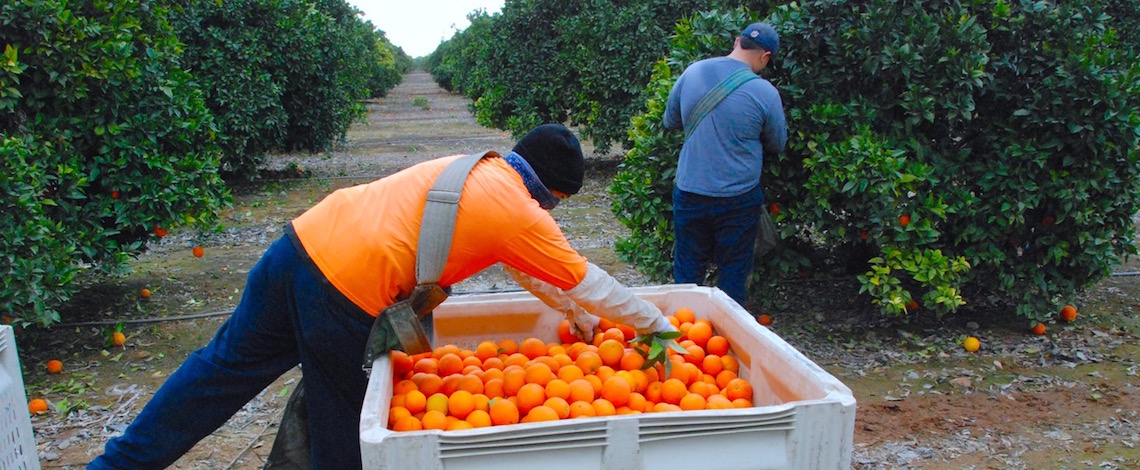
File photo
Written by
As the weather turns cold, citrus groves across the Valley should be active, as workers pick the latest navel orange crop.
But many such groves have been quieter than normal in recent days, an unwanted lull in the industry as growers deal with the fallout of the trade war that began earlier this year between the U.S. and China, with each side imposing tariffs on the other’s imported goods.
That conflict, which began with steel and aluminum, has grown to include several California agricultural products, citrus among them, with no clear signs of when this dispute may end.
As a result, citrus growers are putting off some of their harvesting while they wait to find out how much the tariffs may affect Chinese orders of U.S. navels – information on which probably will start coming in a couple of weeks into January, said Joel Nelsen, president and CEO of California Citrus Mutual, the Exeter-based nonprofit trade association representing about 2,500 citrus growers across the state.
The news comes at a time when citrus growers are anticipating higher production this year over the previous one, but their profitability may not be as high, as prices paid for have been down so far this year and may continue the trend at least for the harvest going into the start of 2019.
Tariffs may be part of the reason, because if the added tariffs soften demand for California citrus among Chinese consumers, that could hurt demand in other markets and reduce prices for the fruit paid by other U.S. and foreign buyers.
Even if tariffs were not an issue, farmers still would be dealing with uncertainty of how well the 2018-19 season will work out.
Though the Valley’s drought is in the rear-view mirror – at least for now – this past summer was hard on citrus groves here, as the Fresno area alone experienced 57 days of temperatures 100 degrees or hotter, well above the yearly average of 36 days.
That added heat can affect trees. In this case, it’s estimated that overall commercial citrus trees in the Valley will produce more fruit, but mandarins, harvested earlier this year, were smaller than average, and the same appears to be true of navels.
Size is particularly important when it comes to marketing navels, as consumer tend to like them about softball sized, Nelsen said.
Instead, “Small sizes dominate the number [of fruit] on tree and per acre,” according to a forecast report issued by Citrus Mutual earlier this year.
“The question becomes whether industry can create sufficient revenues per carton on small sizes to create the revenues per acre to cover costs. Historically, supply exceeds demand in the marketplace as it pertains to small-size fruit,” the forecast continues.
Adding to the problem for growers is that production of California citrus exceeded the foreign market demand from October through early December, so prices already were dampened.
But at least on the fruit size front, demand for mandarins stayed high, even if the fruit was smaller than average, according to the report.
As for navels, things could turn around in the coming weeks, as rain ahead of the harvest period can be beneficial, causing the fruit to plump up on the branches.
Nelsen said storms that hit the Valley around Thanksgiving were a good step in this direction, as was wet weather around Christmas time.
And while growers aren’t intentionally delaying their harvesting to let that happen, the lull in picking due to the tariff conflict is allowing navels in inactive groves to grow more.
So by the early January, growers here should be picking larger, more marketable navels, though whether they’ll be average sized and how profitable they’ll be remain big questions.
Also in the report, Citrus Mutual officials note that 2018 had more competition for U.S. citrus, as foreign countries beefed up their own citrus production and export activities, among them Peru, Australia and Chili, many of which can produce fruit cheaper than U.S. farmers, though not with the same quality, Nelsen noted.
Brazil and Mexico are fairing particularly well shipping orange juice to the U.S., as both small and major juice makers turn to them to try to make up for dwindling supplies from Florida, the nation’s top citrus producer for juicing.
As a result of years of crop losses from a devastating citrus disease, huanglongbing – or “HLB” – “Domestic orange acreage is down almost 40 percent from its high of 20 years ago,” most of that loss occurring in Florida, according to an industry report issued by CoBank.
“Projections by the Florida Department of Citrus suggest that production is expected to decline modestly over the next decade as tree mortality rates continue to exceed replanting rates.”








